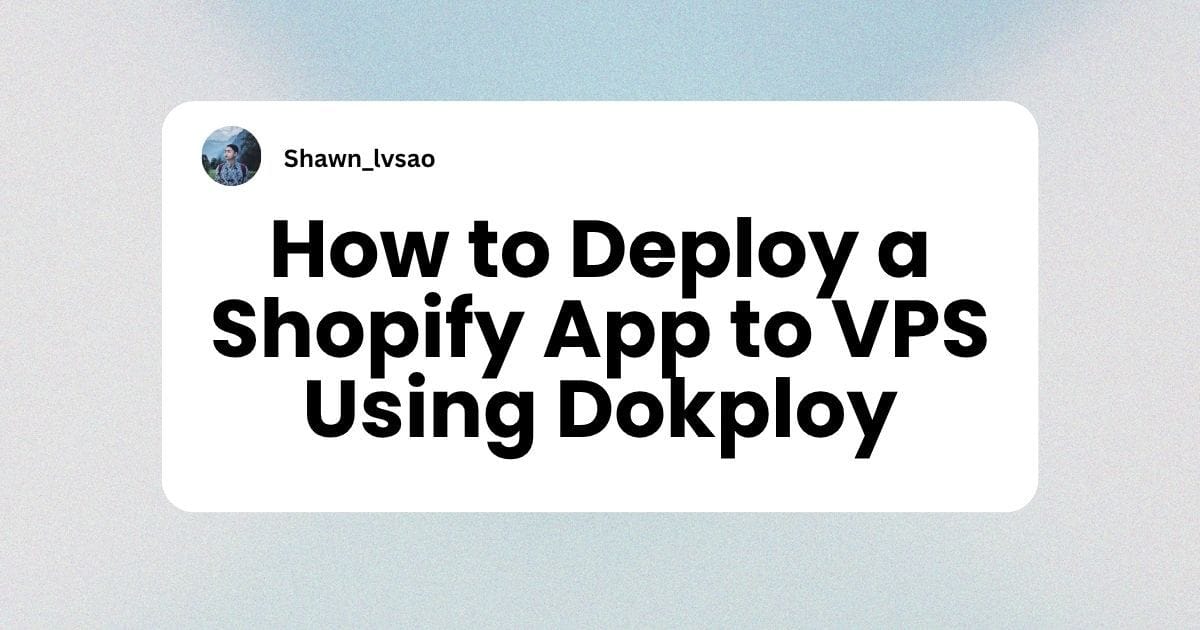Cloud Proxy API Service Deployment Guide
Watch Video Tutorial
Background Problem
When developing Shopify apps that integrate with external services like Google APIs, developers frequently face network and stability challenges:
- Local Development Limitations: Direct API calls from localhost often fail due to network security restrictions.
- Tunnel Instability: Development tunnels (like Ngrok) can be unreliable for handling consistent, high-volume API requests.
- Geographic Restrictions: Server location heavily impacts latency and compliance for specific APIs.
- Rate Limiting: Shared development IP addresses can quickly hit API rate limits.
The definitive solution is to deploy a dedicated, self-hosted cloud proxy service that routes API requests through a stable, persistent server.
Vercel Deployment Challenges
Initial attempts to deploy this service on serverless platforms like Vercel failed due to fundamental limitations:
1. Serverless Function Constraints
- Strict Timeout Limit: Serverless functions are typically limited to a short execution time (e.g., 10 seconds), insufficient for long-running or batch API requests.
- Cold Start Delays: Latency incurred by cold starts severely impacts the responsiveness of the proxy.
- Memory Limitations: Constraints on memory make processing large API responses difficult.
2. Network and Security Issues
- Non-Persistent Connections: Lack of persistent connections between function invocations.
- Inconsistent IP Addresses: The dynamic nature of serverless execution makes IP whitelisting for API access impossible.
3. Cost and Control Problems
- High Per-Request Cost: Cost models are unsuitable for frequent, high-volume proxy calls.
- Limited Control: Lack of full control over the execution environment, logging, and performance tuning.
These issues necessitate a self-hosted, containerized approach for a reliable production proxy.
Self-Hosted Server Deployment
Prerequisites
- VPS or dedicated server with a public IP (e.g., AWS EC2, DigitalOcean Droplet)
- Docker and Docker Compose installed
- Domain name configured with DNS access
- Basic Linux command line knowledge
Step 1: Create Proxy Service (server.js)
This Node.js server provides a secure /proxy endpoint, enforces an API key check, and intelligently handles target API responses (JSON vs. raw text) with a 30-second timeout.
// server.js - Secure Node.js Proxy Server
const express = require('express');
const cors = require('cors');
const app = express();
const PORT = process.env.PORT || 8765;
app.use(cors());
app.use(express.json({ limit: '5mb' })); // Allow up to 5MB request body
// Health check endpoint
app.get('/health', (req, res) => {
res.json({ status: 'ok', timestamp: new Date().toISOString() });
});
// Main proxy endpoint
app.post('/proxy', async (req, res) => {
// CRITICAL SECURITY CHECK: Validate API Key from the client header
const expectedSecret = process.env.PROXY_SECRET;
const clientKey = req.headers['x-api-key'];
if (expectedSecret && clientKey !== expectedSecret) {
// Return 401 if the key is invalid or missing
return res.status(401).json({ error: 'Unauthorized', message: 'Missing or invalid X-API-Key header.' });
}
try {
const { url, method = 'GET', headers = {}, body } = req.body;
// Timeout configuration (30 seconds)
const controller = new AbortController();
const timeoutId = setTimeout(() => controller.abort(), 30000);
const response = await fetch(url, {
method,
headers: {
// Ensure a standard User-Agent is sent to the target API
'User-Agent': 'Mozilla/5.0 (compatible; CloudProxy/1.0)',
...headers
},
// Serialize body for methods that typically carry a payload
body: method !== 'GET' && method !== 'HEAD' ? JSON.stringify(body) : undefined,
signal: controller.signal // Apply the timeout signal
});
clearTimeout(timeoutId);
// Intelligent parsing based on Content-Type header
const contentType = response.headers.get('content-type');
let data;
if (contentType && contentType.includes('application/json')) {
try {
data = await response.json();
} catch (e) {
// Fallback to text if JSON parsing fails
data = await response.text();
}
} else {
// For non-JSON responses (HTML, XML, raw text)
data = await response.text();
}
// Return the structured response containing the target API details
res.status(200).json({
status: response.status, // The actual HTTP status from the target API
statusText: response.statusText,
data: data,
headers: Object.fromEntries(response.headers.entries()),
isError: !response.ok // Flag if the target API returned an error status (4xx, 5xx)
});
} catch (error) {
console.error('Proxy internal execution error:', error.message);
// Handle timeout (AbortError) and other internal proxy errors
res.status(500).json({
error: 'Proxy execution failed',
message: error.message
});
}
});
app.listen(PORT, () => {
console.log(`Cloud proxy server running on port ${PORT}`);
});
Step 2: Docker Configuration
package.json (Dependencies)
// package.json - Dependency file
{
"name": "cloud-proxy",
"version": "1.0.0",
"main": "server.js",
"dependencies": {
"express": "^4.18.2",
"cors": "^2.8.5"
},
"scripts": {
"start": "node server.js"
}
}
Dockerfile (Image Build)
# Dockerfile - Used to build the Node.js service container image
FROM node:18-alpine
WORKDIR /app
COPY package*.json ./
# Install only production dependencies for efficiency
RUN npm ci --only=production
COPY . .
EXPOSE 8765
CMD ["node", "server.js"]
docker-compose.yml (Deployment Configuration)
IMPORTANT: You must replace YOUR_VERY_STRONG_API_KEY_HERE with a complex, unique secret key.
# docker-compose.yml - Docker Compose deployment file
version: '3.8'
services:
cloud-proxy:
build: .
ports:
- "8765:8765" # Map host port to container port
environment:
- NODE_ENV=production
- PORT=8765
# CRITICAL: Define the secret key used for client authentication
- PROXY_SECRET=YOUR_VERY_STRONG_API_KEY_HERE
restart: unless-stopped
healthcheck:
test: ["CMD", "curl", "-f", "http://localhost:8765/health"]
interval: 30s
timeout: 10s
retries: 3
Step 3: Deploy the Service
Run these commands in the directory containing the four configuration files above:
# Command Line - Service Deployment
# Create project directory (if starting fresh)
mkdir cloud-proxy && cd cloud-proxy
# Place server.js, package.json, Dockerfile, docker-compose.yml here
# Build and start the service (using -d for detached mode)
docker-compose up -d
# Check container status
docker-compose ps
# View real-time logs
docker-compose logs -f
4. Security Hardening (CRITICAL)
The proxy service must be protected to prevent unauthorized use and abuse.
Action: Implement API Key Protection
- Generate Key: Create a robust, unique API key.
- Configure Key: Set this key as the
PROXY_SECRETin yourdocker-compose.yml. - Server Verification: The
server.jsfile enforces that the client must provide this key in theX-API-Keyheader.
5. Configure Domain and SSL (Nginx)
Set up a reverse proxy using Nginx to handle SSL termination and route traffic to the Docker container.
# Nginx Configuration Example - /etc/nginx/sites-available/proxy.yourdomain.com
server {
listen 80;
server_name proxy.yourdomain.com;
location / {
proxy_pass http://localhost:8765;
proxy_set_header Host $host;
proxy_set_header X-Real-IP $remote_addr;
proxy_set_header X-Forwarded-For $proxy_add_x_forwarded_for;
proxy_set_header X-Forwarded-Proto $scheme;
# Increase timeouts for API requests
proxy_connect_timeout 60s;
proxy_send_timeout 60s;
proxy_read_timeout 60s;
}
}
Enable SSL using Let's Encrypt and Certbot:
# Command Line - SSL Configuration
# Install certbot
sudo apt install certbot python3-certbot-nginx
# Get SSL certificate
sudo certbot --nginx -d proxy.yourdomain.com
# Enable site configuration and reload Nginx
sudo ln -s /etc/nginx/sites-available/proxy.yourdomain.com /etc/nginx/sites-enabled/
sudo nginx -t && sudo systemctl reload nginx6. Client Integration (cloud-proxy.client.js)
The client utility must send the required secret key and handle the structured JSON response returned by the proxy server.
// cloud-proxy.client.js - Client Utility Function for Cloud Proxy
const CLOUD_PROXY_ENDPOINT = '[https://proxy.yourdomain.com/proxy](https://proxy.yourdomain.com/proxy)';
// IMPORTANT: This key must be securely stored in your application's environment
const PROXY_SECRET = 'YOUR_VERY_STRONG_API_KEY_HERE';
async function fetchViaCloudProxy(url, options = {}) {
const controller = new AbortController();
// Client-side timeout (shorter than server-side 30s timeout)
const timeoutId = setTimeout(() => controller.abort(), 25000);
try {
const proxyResponse = await fetch(CLOUD_PROXY_ENDPOINT, {
method: 'POST',
headers: {
'Content-Type': 'application/json',
'X-API-Key': PROXY_SECRET, // 🔑 CRITICAL: Send the secret key for authentication
'User-Agent': 'Mozilla/5.0 (compatible; AppClient/1.0)',
},
body: JSON.stringify({
url,
method: options.method || 'GET',
headers: options.headers || {},
body: options.body
}),
signal: controller.signal
});
clearTimeout(timeoutId);
// 1. Handle Proxy Service Errors (e.g., 401 Unauthorized, 500 Internal Proxy Error)
if (!proxyResponse.ok) {
const errorBody = await proxyResponse.json();
throw new Error(`Proxy Service Error (${proxyResponse.status}): ${errorBody.message || 'Unknown proxy error'}`);
}
// 2. Extract and Process Target API Response from Proxy payload
const proxyPayload = await proxyResponse.json();
// If the target API returned an error status (e.g., 400, 404, 503)
if (proxyPayload.isError) {
console.error(`Target API Error (${proxyPayload.status}):`, proxyPayload.data);
const error = new Error(`API call failed with status ${proxyPayload.status}`);
error.status = proxyPayload.status;
error.data = proxyPayload.data;
error.headers = proxyPayload.headers;
throw error;
}
return proxyPayload.data; // Return the successfully fetched data
} catch (error) {
clearTimeout(timeoutId);
throw error;
}
}
// Smart fetch with fallback to direct request if proxy fails
async function smartFetch(url, options = {}) {
try {
// Try cloud proxy first
return await fetchViaCloudProxy(url, options);
} catch (error) {
console.warn('Cloud proxy failed, attempting direct request fallback:', error.message);
// Fallback to direct request (may fail due to network restrictions)
return await fetch(url, options);
}
}
7. Environment Configuration
Update your application's environment variables to use the new proxy:
# .env
USE_CLOUD_PROXY=true
CLOUD_PROXY_ENDPOINT=[https://proxy.yourdomain.com/proxy](https://proxy.yourdomain.com/proxy)
CLOUD_PROXY_SECRET=YOUR_VERY_STRONG_API_KEY_HERE
Key Benefits
- Reliability: Dedicated server with a static IP address for whitelisting.
- Performance: Optimized for long API requests with 30-second timeouts.
- Control: Full control over proxy configuration, logging, and environment updates.
- Cost-Effective: Predictable, fixed monthly server cost vs. serverless per-request pricing.
- Security: Protected by a mandatory, secret API key (
X-API-Keyheader). - Geographic Optimization: Deploy in regions closest to target APIs for optimal latency.

.jpg)






